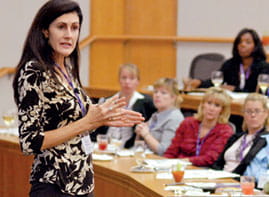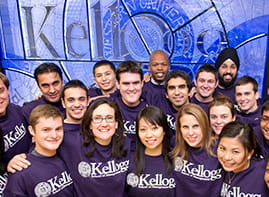Through cutting-edge research, teaching and partnerships, Kellogg prepares students to lead through tech innovation
1/5/2018 -
News about technological developments is often accompanied by broad, buzz-worthy statements. Among the favorites of Adam Pah, clinical assistant professor of management and organizations at the Kellogg School of Management, is from software entrepreneur and investor Marc Andreeson, published in The Wall Street Journal in August 2011: “Software is eating the world.”
Andreeson was describing the way that societies are moving from hardware-based systems of commerce to software-based systems. For 2017, Pah believes the more apt version of the axiom is that “Artificial intelligence and machine learning are eating software.”
Because of the shifting data science landscape, Pah’s Human-Machine Intelligence (HMI) course is a key part of the Kellogg Architectures of Collaboration Initiative (KACI), and crucial for any current or prospective MBA student pursuing a career that involves leveraging machine learning, a career type that is ever-widening.
“It’s not a question of how much artificial intelligence and human-machine intelligence will penetrate,” Pah said, “but rather, will anyone still be able to hold on without using AI/HMI, in a competitive market area?”
Exactly how machine learning is changing business at the moment depends on the organization in question, Pah said, but generally companies are using it in similar ways, and using it extensively. Machine learning – the process by which machines use algorithms to identify patterns in data sets and make predictions based on those patterns, without needing to be programmed to do so – is a major time saver for large companies.
“Machine learning is allowing better insights to be mined from data that organizations already own or have access to, which means they can be more productive with their time,” Pah said, “and focus more on the human relationship element that is vital to making everything run smoothly.”
Pah’s Human-Machine Intelligence course encourages students to confront important questions: “How do people fit into this evolving space? What do our interactions look like? How do we manage this process when introducing machine learning? How do we maintain vision around AI/HMI and what it can do?”
These questions are answerable only through engagement and experimentation. Through Kellogg’s emphasis on teamwork and community problem-solving, a heritage that goes back to the 1970s, Pah believes Kellogg offers students an experience no other school can.
Brian Uzzi, Richard L. Thomas Professor of Leadership and Organizational Change and faculty director of the Kellogg Architectures of Collaboration Initiative (KACI), shares this view.
KACI’s human-machine intelligence focus, Uzzi said, enables faculty to prepare students to address the three things machine learning can do for business:
First, it can help people overcome previously unsolvable human biases in decision-making. Second, it can help extend human consciousness, or increase and improve awareness of tasks, themselves and other people. And third, it enables significant increases in the scaling of human effort. Together, those three things make up what Uzzi calls the “mind-plus-machine partnership.”
This partnership, rather than being a complete reworking of past relationships among collaborators, is based on the same model, albeit a turbo-charged one. “The way we’ve always tried to overcome our limitations as individuals is through collaboration with other people,” he said. “And we’re going to continue to do that, but now we have this new entity we can include in that collaboration.”

Brian Uzzi, the Richard L. Thomas Professor of Leadership and Organizational Change and faculty director of the Kellogg Architectures of Collaboration Initiative (KACI)
As part of the HMI course, Pah leverages the convening power of Kellogg to invite industry leaders, innovators and experts to speak to his students. In May 2017, the guest speaker was
David Ferrucci, who led the team that built the Watson computer system for IBM.
Since Watson’s famous win on the
Jeopardy! game show in 2011, the system has become exactly the kind of new collaborative entity Uzzi mentioned. Starting in 2013, Memorial Sloan Kettering Cancer Center in New York City became the first commercial application of Watson software, which the hospital uses to assess the appropriateness of patient care decisions.
But as exciting as the possibilities of machine learning and artificial intelligence are, Ferrucci said, it’s important to clear up a common misconception, specifically concerning machine learning. “I think that word ‘learning’ for machine learning in computer science has a very different connotation than it does when humans think about human learning,” he said.
While certain mechanisms in the human brain operate similarly to how a machine might recognize statistical patterns in a data set, for example, the learning process in the human brain is orders of magnitude deeper and more complex than the surface-level language recognition that machines are currently capable of doing. It’s important for students, data scientists and commercial clients alike to keep that in mind, Ferrucci said.
Max Meyers ’17, took Pah’s HMI course and praised his experience at Kellogg for grounding him in the reality of what can be accomplished and empowering him to pursue its potential. “What I really liked about the course,” he said, “was how it made AI real.” Meyers said that rather than being dizzyingly technical or getting lost in high-level abstractions, Pah’s course is based in real-world tools and applications, both current and possible.
The tool that was most interesting to Meyers, formerly a senior organization and talent consultant at Deloitte, and now a manager there, was the job posting tool. This tool, which he learned to use during the class, tested the language and visibility of his job postings to ensure the best possible applicants for an advertised position. “It challenged things I never would have thought about,” he said, “and it challenged deeply held biases of mine.”
For example, he said, the tool identified certain unproductive habits in his posting process, as well as words that showed unconscious biases. When faced with those results, he realized the conflict of results and preconceptions, within an environment that encouraged learning and growth, which enabled him to reflect on his practices as a whole and how he needed to change his approach.
This seeking attitude toward change and possibility, Pah said, is more important to cultivate than specific engineering or technical specialization, precisely because it isn’t bound to a single set of circumstances or criteria. “I try to communicate in class that the algorithm doesn’t matter,” he said. “The entire class revolves around this concept of accepting and understanding that the machine is essentially a team member to you.”
The class features a number of alumni case studies, bringing current research and practice into the classroom and demonstrating how the concept plays out in live industry environments. The studies also help connect students to the vast
Kellogg alumni network.
According to Uzzi, the collaboration extends even to the corporate partnerships like the one that facilitated Ferrucci’s visit to the HMI course. “Our job as faculty members is to identify the science and translate it into a way that’s most useful for our students,” he said. “And when you’re working with corporate partnerships, you really learn how to make that translation.”
The ultimate goal, of course, is to prepare students for the job market, but that goal is tempered by the necessity of doing so in a way that prepares them not merely to find a job right out of the gate, but to do so in a way that sets them up to be long-term leaders.
“That kind of information comes into the classroom so readily,” Uzzi said, “that students really come out on the job market with a great leg up on their competition, already being able to go into an organization and take on high-level leadership positions.”
The opportunity exists to revisit current approaches to collaboration and integrate a model in which both the machine and the humans using it are learning. The real challenge, one that Kellogg has risen to meet, lies in preparing students for the journey into an unwritten and exciting future where they will build on and build out the possibilities of human consciousness.
Related reading
Kellogg’s Man + Machine > Man or Machine blog focuses on human-machine learning
Read more >
Faculty weigh in on how humans benefit as machines get smarter in Kellogg Insight
Read more >
Will machines ever truly understand humans? Kellogg faculty weigh in on the Kellogg Insight podcast
Listen now >
Kellogg partner David Ferrucci shares why Watson is just the beginning for machine learning in Kellogg Insight
Read more >






